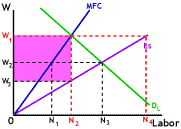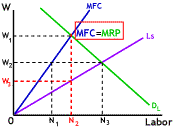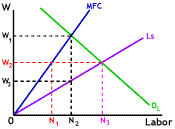| a. |  | Wage = W2 and Labor = N3. If the firm offers wage W2 and hires N3, the cost of hiring all the workers greater than N2 in number exceeds the added revenue they generate. Indeed by hiring at this point it incurs unnecessary losses equal to the shaded area on the graph to the left. In other words, above N2 workers MFC > MRP |
| b. |  | Wage = W1 and Labor = N2. Only a wage of W3 is required to hire N2 workers so right off the firm is paying too much. At a wage of W1 the firm could hire as many as N4 workers. If it insists on doing this anyway it is spending far more on labor that is needed thus reducing its profits by an amount equal to the shaded area to the left. |
| c. |  | Wage = W3 and Labor = N3. As we can see from the graph to the left, this isn't even a possibility. At a wage of W3 only N2 workers are willing to accept the job.
|
| d. |  | Wage = W3 and Labor = N2. This is correct because at this point the marginal cost of an added worker equals her added benefit. |
| e. |  | Wage = W2 and Labor = N1 A wage of W2 is far greater than what is needed to hire n1 workers and, as we saw in answer a. W2 is too high a wage anyway.
|











